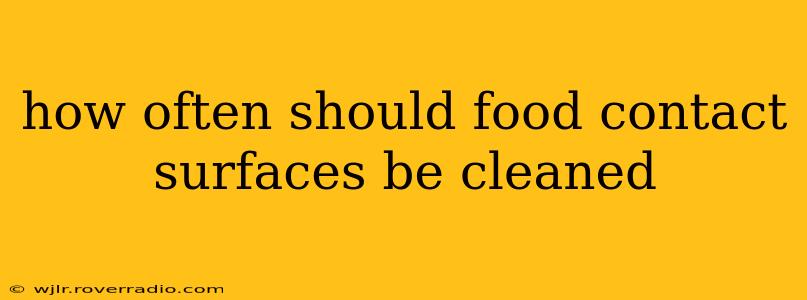Maintaining a clean and sanitary kitchen is crucial for preventing foodborne illnesses. Knowing how often to clean food contact surfaces is a key component of this. This comprehensive guide will delve into the frequency of cleaning, best practices, and answer common questions surrounding this important aspect of food safety.
The short answer? Food contact surfaces should be cleaned and sanitized frequently, ideally after each use, but at minimum, at the end of each shift. However, the specific frequency depends on several factors, which we'll explore in detail.
What are Food Contact Surfaces?
Before diving into cleaning frequencies, let's clarify what constitutes a food contact surface. These are any surfaces that come into direct contact with food during preparation, processing, storage, or serving. This includes:
- Utensils: Knives, cutting boards, spoons, spatulas, etc.
- Equipment: Food processors, mixers, blenders, slicers, etc.
- Containers: Bowls, plates, cups, storage containers, etc.
- Countertops: Work surfaces where food is handled.
- Sinks: Especially crucial due to potential cross-contamination.
How Often Should You Clean and Sanitize Food Contact Surfaces?
The ideal scenario involves cleaning and sanitizing food contact surfaces after each use. This is especially important when handling raw meat, poultry, seafood, or eggs. Cross-contamination is a major concern, and immediate cleaning prevents the spread of harmful bacteria.
However, this isn't always feasible in high-volume settings. In such cases, a practical approach involves cleaning and sanitizing:
- At the end of each task: If you've finished prepping vegetables, clean and sanitize the cutting board and knife before moving on to meat.
- At the end of each shift: Thorough cleaning and sanitizing are essential at the close of business to ensure everything is ready for the next day.
- After spills or splashes: Any spills of raw food or potentially hazardous materials need immediate attention to prevent contamination.
- Before and after handling different types of food: Prevent cross-contamination by cleaning between raw meat and ready-to-eat foods.
What About Different Types of Food?
The type of food handled can influence the cleaning frequency. Raw meat, poultry, and seafood require more immediate and thorough cleaning due to higher risks of bacterial contamination. Ready-to-eat foods, while still requiring cleaning, pose less of a threat.
What are the Best Practices for Cleaning Food Contact Surfaces?
Cleaning food contact surfaces isn't just about wiping them down. A proper cleaning process involves several steps:
- Scrape or remove food debris: Use a spatula or scraper to remove large pieces of food before washing.
- Wash with hot, soapy water: Use a detergent specifically designed for food contact surfaces.
- Rinse thoroughly: Remove all soap residue to prevent contamination.
- Sanitize: Use a food-grade sanitizer according to manufacturer instructions. Allow the surface to air dry.
How Long Should Food Contact Surfaces be Sanitized?
Sanitizing times vary depending on the sanitizer used. Always follow the manufacturer's instructions for contact time to ensure effectiveness. This is usually specified on the product label.
What are the Consequences of Improper Cleaning?
Neglecting proper cleaning and sanitizing of food contact surfaces can lead to:
- Foodborne illnesses: Bacteria, viruses, and parasites can survive on unclean surfaces and contaminate food.
- Spoilage: Food can spoil more quickly due to bacterial growth.
- Reputational damage: For businesses, improper hygiene can lead to negative reviews and loss of customers.
What Cleaning Agents Are Recommended?
Use cleaning agents specifically designed for food contact surfaces. Many commercial and home-use products are available, and it's important to follow the directions on the product labels.
By following these guidelines and prioritizing cleanliness, you can significantly reduce the risk of foodborne illnesses and maintain a safe and hygienic environment for food preparation. Remember, consistency is key!
